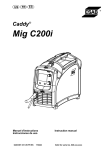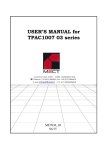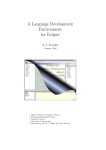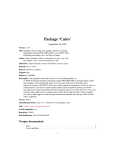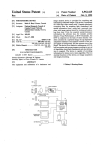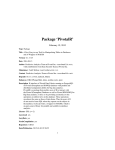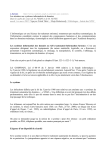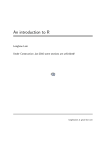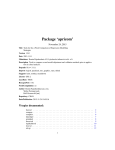Download Package `rapport`
Transcript
Package ‘rapport’ November 18, 2015 Maintainer Gergely Daróczi <[email protected]> Title A Report Templating System Type Package Encoding UTF-8 Description Facilitating the creation of reproducible statistical report templates. Once created, rapport templates can be exported to various external formats (HTML, LaTeX, PDF, ODT etc.) with pandoc as the converter backend. Author Aleksandar Blagotić <[email protected]> and Gergely Daróczi <[email protected]> Version 1.0 Date 2015-11-15 URL http://rapport-package.info/ BugReports https://github.com/rapporter/rapport/issues License AGPL-3 LazyData yes LazyLoad yes Depends R (>= 2.15.0) Imports grDevices, utils, yaml, stringr, rapportools, pander SystemRequirements pandoc (http://johnmacfarlane.net/pandoc) for exporting markdown files to other formats. NeedsCompilation no Repository CRAN Date/Publication 2015-11-18 09:38:09 1 R topics documented: 2 R topics documented: rapport-package . . . . . . as.character.rapport.inputs as.character.rapport.meta . as.yaml.bool . . . . . . . . check.input.value . . . . . check.input.value.class . . check.report.chunks . . . . check.tpl . . . . . . . . . . extract.meta . . . . . . . . get.tags . . . . . . . . . . guess.input . . . . . . . . guess.input.description . . guess.input.label . . . . . guess.input.name . . . . . guess.l . . . . . . . . . . . guess.old.input.length . . . guess.old.input.type . . . . inputs-deprecated . . . . . is.rapport . . . . . . . . . ius2008 . . . . . . . . . . print.rapport . . . . . . . . print.rapport.info . . . . . print.rapport.inputs . . . . print.rapport.meta . . . . . rapport . . . . . . . . . . . rapport-helpers . . . . . . rapport.body . . . . . . . . rapport.check.template . . rapport.docx . . . . . . . . rapport.example . . . . . . rapport.export . . . . . . . rapport.header . . . . . . . rapport.html . . . . . . . . rapport.info . . . . . . . . rapport.inputs . . . . . . . rapport.ls . . . . . . . . . rapport.meta . . . . . . . . rapport.odt . . . . . . . . . rapport.path . . . . . . . . rapport.path.add . . . . . . rapport.path.remove . . . . rapport.path.reset . . . . . rapport.pdf . . . . . . . . rapport.read . . . . . . . . rapport.renew . . . . . . . rapport.rerun . . . . . . . . . . . . . . . . . . . . . . . . . . . . . . . . . . . . . . . . . . . . . . . . . . . . . . . . . . . . . . . . . . . . . . . . . . . . . . . . . . . . . . . . . . . . . . . . . . . . . . . . . . . . . . . . . . . . . . . . . . . . . . . . . . . . . . . . . . . . . . . . . . . . . . . . . . . . . . . . . . . . . . . . . . . . . . . . . . . . . . . . . . . . . . . . . . . . . . . . . . . . . . . . . . . . . . . . . . . . . . . . . . . . . . . . . . . . . . . . . . . . . . . . . . . . . . . . . . . . . . . . . . . . . . . . . . . . . . . . . . . . . . . . . . . . . . . . . . . . . . . . . . . . . . . . . . . . . . . . . . . . . . . . . . . . . . . . . . . . . . . . . . . . . . . . . . . . . . . . . . . . . . . . . . . . . . . . . . . . . . . . . . . . . . . . . . . . . . . . . . . . . . . . . . . . . . . . . . . . . . . . . . . . . . . . . . . . . . . . . . . . . . . . . . . . . . . . . . . . . . . . . . . . . . . . . . . . . . . . . . . . . . . . . . . . . . . . . . . . . . . . . . . . . . . . . . . . . . . . . . . . . . . . . . . . . . . . . . . . . . . . . . . . . . . . . . . . . . . . . . . . . . . . . . . . . . . . . . . . . . . . . . . . . . . . . . . . . . . . . . . . . . . . . . . . . . . . . . . . . . . . . . . . . . . . . . . . . . . . . . . . . . . . . . . . . . . . . . . . . . . . . . . . . . . . . . . . . . . . . . . . . . . . . . . . . . . . . . . . . . . . . . . . . . . . . . . . . . . . . . . . . . . . . . . . . . . . . . . . . . . . . . . . . . . . . . . . . . . . . . . . . . . . . . . . . . . . . . . . . . . . . . . . . . . . . . . . . . . . . . . . . . . . . . . . . . . . . . . . . . . . . . . . . . . . . . . . . . . . . . . . . . . . . . . . . . . . . . . . . . . . . . . . . . . . . . . . . . . . . . . . . . . . . . . . . . . . . . . . . . . . . . . . . . . . . . . . . . . . . . . . . . . . . . . . . . . . . . . . . . . . . . . . . . . . . . . . . . . . . . . . . . . . . . . . . . . . . . . . . . . . . . . . . . . . . . . . . . . . . . . . . . . . . . . . . . . . . . . . . . . . . . . . . . . . . . . . . . . . . . . . . . . . . . . . . . . . . . . . . . . . . . . . . . . . . . . . . . . . . . . . . . . . . . . . . . . . . . . . . . . . . . . . . . . . . . . . . . . . . . . . . . . . . . . . . . . . . . . . . . . . . . . . . . . . . . . . . . . . . . . . . . . . . . . . . . . . . . . . . . . . . . . . . . . . . . . . . . . . . . . . . . . . . . . . . . . . . . . . . . . . . . . . . . . . . . . . . . . . . . . . . . . . . . . . . . . . . . . . . . . . . . . . . . . . . . . . . . . . . . . . . . . . . . . . . . . . . . . . . . . . . . . . . . . . . . . . . . . . . . . . . . . . . . . . . . . . . . . . . . . . . . . . . . . . . . . . . . . . . . . . . . . . . . . . . . . . . . . . . . . . . . . . . . . . . . . . . . . . . . . . . . . . . . . . . . . . . . . . . . . . . . . . . . . . . . . . . . . . . . . . . . . . . . . . . . . . . . . . . . . . . . . . . . . . . . . . . . . . . . . . . . . . . . . . . . . . . . . . . . . . . . . . . . . . . . . . . . . . . . . . . 3 4 4 5 5 6 6 7 7 8 9 9 10 10 10 11 11 12 14 14 16 16 17 17 18 19 21 22 22 23 23 25 26 26 27 29 30 31 31 32 32 33 33 34 34 35 rapport-package 3 rapport.tangle . . . . . . . . . . . . . . . . . . . . . . . . . . . . . . . . . . . . . . . . 35 Index 36 rapport-package rapport: an R engine for reproducible template generation Description rapport is an R package that facilitates creation of reproducible statistical report templates. Once created, rapport templates can be exported to various external formats: HTML, LaTeX, PDF, ODT, etc. Details For detailed introductions please check out our homepage: http://rapport-package.info. You may use the package-bundled templates with a minimal R knowledge - a quick tutorial is shown in the package demo: demo(rapport, ask = FALSE). Apart from R, all you need to know to start writing your own templates is Pandoc’s markup syntax, and several rapport-specific conventions that allow the reproducible of the template. rapport uses brew-like tags to support dynamic inline and/or block evaluation of R code. Unlike many other report-writing conventions in R (Sweave, brew, knitr), rapport converts generated output to a convenient form via pander package and pandoc as the document converting backend. rapport also comes with support for plots: images are automatically saved to temporary file, and image path is returned or redrawn on demand. The output of rapport command depends on various package-specific options. Please skim through the summary of following options: • rapport.user: a (user)name to show in exported report (defaults to "Anonymous") • rapport.file.name: a general filename of generated images and exported documents without extension. Some helper pseudo-code would be replaced with handy strings while running rapport and rapport.export: – %t: unique random character strings based on tempfile, – %T: template name in action, – %n: an auto-increment integer based on similar (plot) file names (see: ?evalsOptions), – %N: an auto-increment integer based on similar exported document’s file name • rapport.file.path: a directory where generated images and exported documents would take place. • By default rapport function saves plots to image files (see the settings in evalsOptions()) and print method just shows the path(s) of the generated image(s). If you would like to see the plot(s) when calling rapport function from an interactive R console, please set evalsOptions('graph.recordplot') and the global rapport.graph.replay option to TRUE beforehand. In that case all generated plots will be displayed after printing the rapport object. These options are set to FALSE by default although we find these settings really handy, as you can resize the images on the fly and export resized images to HTML/ODT/DOCX/PDF etc. If you would even like to save the actual environment of each generated plot (variables, data sets etc.) as an RData file, please set evalsOptions('graph.env') to TRUE. 4 as.character.rapport.meta • rapport also has some options to set formatting style of numbers, characters and dates specified in panderOptions() • the exported graphs can be customised via further panderOptions See Also pander package: http://rapporter.github.com/pander/ as.character.rapport.inputs Convert Inputs to Character Description Converts template inputs to character vector with YAML strings. Usage ## S3 method for class 'rapport.inputs' as.character(x, ...) Arguments x template inputs object ... ignored as.character.rapport.meta Convert Metadata to Character Description Converts template metadata to character vector with YAML strings. Usage ## S3 method for class 'rapport.meta' as.character(x, ...) Arguments x template metadata object ... ignored as.yaml.bool as.yaml.bool 5 Convert YAML booleans to R ones Description We need this because of the silly R/YAML bug. Chillax, it’s for internal use only, and since we’re about to call it on bunch of places, we needed a function. Usage as.yaml.bool(x) Arguments x check.input.value a character vector with YAML booleans Check input value Description A bit misleading title/function name - it validates input values, according to rules set in general input attributes (length) or class-specific ones (nchar, nlevels or limit). Usage check.input.value(input, value = NULL, attribute.name = c("length", "nchar", "nlevels", "limit")) Arguments input input item value input value, either template-defined, or set by the user attribute.name input attributes containing validation rules (defaults to length) 6 check.report.chunks check.input.value.class Check Input Value Class Description Checks the class of an input value. Usage check.input.value.class(value, class = c("character", "complex", "factor", "integer", "logical", "numeric", "raw"), input.name = NULL) Arguments value input value class input class (defaults to NULL) input.name input name (used in messages) check.report.chunks Check Report Chunks Description Checks for warnings and errors in report chunks. Usage check.report.chunks(rp, what = c("errors", "warnings", "messages")) Arguments rp rapport object what what fields to check. defaults to all check.tpl check.tpl 7 Check template validity Description Throw error Usage check.tpl(txt, open.tag = get.tags("header.open"), close.tag = get.tags("header.close"), ...) Arguments txt character vector with template contents open.tag opening tag regexp close.tag closing tag regexp ... additional params for tag matching (see grep) extract.meta Extract Template Metadata Description Check if template metadata field matches provided format, and return matched value in a list. Usage extract.meta(x, title, regex, short = NULL, trim.white = TRUE, mandatory = TRUE, default.value = NULL, field.length = 1000, ...) Arguments x a string containing template metadata title a string containing metadata field title (can be regex-powered) regex a string with regular expression to match field value short a string with a short name for given metadata field trim.white a logical value indicating whether trailing and leading spaces of the given string should be removed before extraction mandatory a logical value indicating required field default.value fallback to this value if non-mandatory field is not found/malformed field.length maximum number of field characters (defaults to 1000) ... additional parameters for grepl function 8 get.tags Value a list with matched content, or NULL if the field is not required Examples ## Not run: rapport:::extract.meta("Name: John Smith", "Name", "[[:alpha:]]+( [[:alpha:]]+)?") ## $name ## [1] "John Smith" rapport:::extract.meta("Name: John", "Name", "[[:alpha:]]+( [[:alpha:]]+)?") ## $name ## [1] "John" ## End(Not run) get.tags Tag Values Description Returns report tag vales (usually regexes): either user-defined, or the default ones. Usage get.tags(tag.type = c("all", "header.open", "header.close", "comment.open", "comment.close"), preset = c("user", "default")) Arguments tag.type a character value with tag value name preset a character value specifying which preset to return Details Default parameters are read from options: • ’header.open’, • ’header.close’, • ’comment.open’, • ’comment.close’. Value either a list (default) or a character value with tag regexes guess.input 9 Examples ## Not run: get.tags() # same as 'get.tags("all")' get.tags("header.open") ## End(Not run) guess.input Guess Input Description Checks and returns valid input from YAML input definition. Usage guess.input(input) Arguments input a named list containing input definition guess.input.description Input Description Description Checks and returns input description. Usage guess.input.description(description) Arguments description a character string containing input description 10 guess.l guess.input.label Input Label Description Checks and returns input label. Usage guess.input.label(label) Arguments label guess.input.name a character string containing input label Input Name Validation Description From v.0.51 one or more characters that are not newline should do the trick. Note that white spaces will be trimmed from both ends in resulting string. Usage guess.input.name(name) Arguments name guess.l a character value with input name Guess length-like fields Description Since length, nchar, nlevels and limit have (almost) same format, Usage guess.l(len, type = c("length", "nchar", "nlevels", "limit"), input.name = NULL, limit.class = c("numeric", "integer")) guess.old.input.length 11 Arguments len length field value, either a number or a named list type type of length-like field input.name input name limit.class input class to perform limit-specific checks guess.old.input.length Deprecated input limits Description Guess deprecated input length. Usage guess.old.input.length(x, input.type) Arguments x a character string containing input length definition input.type a character string containing input type guess.old.input.type Check Type Description Checks type of template input, based on provided sting. If input definition is syntactically correct, a list is returned, containing input type, size limits, and default value (for CSV options and boolean types only). Usage guess.old.input.type(x) Arguments x a character string containing input definition 12 inputs-deprecated inputs-deprecated Deprecated Input Definition Description As of version 0.5, rapport relies on YAML syntax to define inputs. The following sections describe deprecated input definition syntax. Details Input Specifications Apart from template metadata, header also requires specification for template inputs. In most cases, inputs refer to variable names in provided dataset, but some inputs have special meaning inside rapport, and some of them don’t have anything to do with provided dataset whatsoever. Most inputs can contain limit specification, and some inputs can also have a default value. At first we’ll explain input specifications on the fly, and in following sections we’ll discuss each part in thorough details. Let’s start with a single dummy input specification: *foo.bar | numeric[1,6] | Numeric variable | A set of up to 6 numeric variables Required Inputs Asterisk sign (*) in front of an input name indicates a mandatory input. So it is possible to omit input (unless it’s required, of course), but you may want to use this feature carefully, as you may end up with ugly output. If an input isn’t mandatory,NULLis assigned to provided input name, and the object is stored in transient evaluation environment. Input Name rapport has its own naming conventions which are compatible, but different from traditional R naming conventions. Input name ("foo.bar" in previous example) must start with an alphabet letter, followed either by other alphabet letters or numbers, separated with _ or .. For example, valid names are: foo.bar, f00_bar, or Fo0_bar.input. Input name length is limited on 30 characters by default. At any time you can check your desired input name with check.name function. Note that input names are case-sensitive, just like symbols in R. Input Type Input type is specified in the second input block. It is the most (read: "only") complex field in an input specification. It consists of type specification, limit specification and sometimes a default value specification. Most input types are compatible with eponymous R modes: character, complex, logical, numeric, or R classes like factor. Some are used as "wildcards", like variable, and some do not refer to dataset variables at all: boolean, number, string and option. Here we’ll discuss each input type thoroughly. We will use term variable to denote a vector taken from a dataset (for more details see documentation for is.variable). All inputs can be divided into two groups, depending on whether they require a dataset or not: • dataset inputs: – character - matches a character variable – complex - matches a character variable – numeric - matches a numeric variable inputs-deprecated 13 – factor - matches a factor variable (i.e. R object of factor class) – variable - matches any variable of previously defined types • standalone inputs: – string - accepts an atomic character vector – number - accepts an atomic numeric vector – boolean - accepts a logical value – option - accepts a comma-separated list of values, that are to be matched with match.arg. The first value in a list is the default one. Now we’ll make a little digression and talk about input limits. You may have noticed some additional stuff in type specification, e.g. numeric[1,6]. All dataset inputs, as well as *string* and *numeric standalone inputs* can contain limit specifications. If you want to bundle several variables from dataset or provide a vector with several string/numeric values, you can apply some rules within square brackets in [a,b] format, where [a,b] stands for "from a to b inputs", e.g. [1,6] means "from 1 to 6 inputs". Limit specifications can be left out, but even in that case implicit limit rules are applied - for variables, as well as boolean and option inputs it’s [1,1], for strings [1,256] and for number inputs [-Inf,Inf]. Dataset inputs will match one or more variables from a dataset, and check its mode and/or class. variable type is a bit different, since it matches any kind of variable (not to confuse with Any type), but it still refers to variable(s) from a provided dataset. Dataset inputs cannot have default value, but can be optional (just leave out * sign in front of input name). Note that if you provide more than one variable name in rapport function call, that input will be stored as a data.frame, otherwise, it will be stored as a variable (atomic vector). Standalone inputs are a bit different since they do not refer to any variables from a dataset. However, they are more complex than *dataset inputs*, especially because they can contain default values. • number and string inputs are defined with number and string respectively. They can also contain limit specifications, but the limits are treated in a slightly different manner. number[-2.58,3] will match any number within an interval from -2.58 to 3. If the limit specification is ommited, an implicit ones are assigned ([-Inf,Inf]. Limit specifications for string inputs define the range of characters that provided string can have, e.g. string[1,6] matches the string with at least 1 and at most 6 characters. If ommited, limit specifications for strings are implicitly set to [1,256]. number and string inputs can have default value, which can be defined by placing = after type/limit specification followed by default value. For instance, number[1,6]=3.14 sets value 3.14 as default. Note that for number inputs an additional check will be applied to ensure that provided default number belongs to an interval defined in the limit specification ([1,6]=7 will throw an error). For string inputs, the default value string=foo sets "foo" as default string value (note that you don’t have to specify quotes unless they are the part of the default string). Default value will be checked to ensure that its length falls within the interval provided in the limit specification. • boolean inputs can contain either TRUE or FALSE values. The specified value is the default one. They cannot contain limit specification, but implicitly the limits are set to [1,1]. • option inputs are nothing more than a comma-separated list of strings. Even if you specify numbers in a list, they will be coerced to strings once the list is parsed. Values in option list will be placed in a character vector, and matched with match.arg function. That means that you could only choose one value from a list. Partial matches are allowed, and the first value in option list is the default one. Just like in boolean inputs, limits are implicitly set to [1,1]. 14 ius2008 Input Label and Description Third block in input definition is an input label. While variable can have its own label (see label), you may want to use the one defined in input specifications. At last, fourth block contains input description, which should be a lengthy description of current input. Note that all the fields in input specification are mandatory. You can cheat, though, by providing a non-space character (e.g. a dot) as an input label and/or description, but please don’t do that unless you’re testing the template. Labels and descriptions are meant to be informative. is.rapport Rapport Object Description Checks if provided R object is of rapport class. Usage is.rapport(x) Arguments x any R object to check Value a logical value indicating whether provided object is a rapport object ius2008 Internet Usage Survey Description This dataset contains data gathered in a survey of Internet usage in Serbian population in the period from April to May 2008. During 90-day period, there were gathered 709 valid responses via on-line distributed questionnaire. Details However, this dataset does not contain the original data, as some random noise is added afterwards, in order to demonstrate functionality of rapport helpers. Dataset variables can be divided into 3 sets: demographic data, Internet usage aspects and application usage/content preference. Demographic variables • gender - respondent’s gender (factor with 2 levels: "male" and "female") ius2008 15 • age - respondent’s age • dwell - dwelling (factor with 3 levels: "village", "small town" and "city") • student - is respondent a student? (factor with 2 levels: "no" and "yes") • partner - partnership status (factor with 3 levels: "single", "in a relationship" and "married") Internet usage aspects Following variables depict various aspects of Internet usage: • edu - time spent on-line in educational purposes (expressed in hours) • leisure - time spent on-line in leisure time (expressed in hours) • net.required - is Internet access required for your profession? (factor with 5 levels: "never", "rarely", "sometimes", "often" and "always") • net.pay - who pays for Internet access? (factor with 5 levels: "parents", "school/faculty", "employer", "self-funded" and "other") • net.use - how long is respondent using Internet? (ordered factor with 7 levels, ranging from "less than 6 months" to "more than 5 years") Application usage and on-line content preference These variables include data on the use of Internet applications and content available on the Internet. Practically, they contain responses from a set of 8 questions on a five-point Likert scale. • chatim - usage of chat and/or instant messaging applications • game - usage of on-line games • surf - frequency of web-surfing • email - usage of e-mail applications • download - frequency of file downloading • forum - attendance at web-forums • socnet - usage of social networking services • xxx - traffic to pornographic websites Author(s) Aleksandar Blagotic <[email protected]> Dusan Vuckovic <[email protected]> Examples ## Not run: rapport("example", ius2008, var = "it.leisure") ## End(Not run) 16 print.rapport.info print.rapport Prints rapport Description Default print method for rapport class objects that shows evaluated report contents. Usage ## S3 method for class 'rapport' print(x, ...) Arguments x any "rapport" class object ... ignored Examples ## Not run: rapport('example', data = mtcars, var='hp') ## End(Not run) print.rapport.info Print Template Header Description Prints out the contents of template header (both metadata and inputs) in human-readable format, so you can get insight about the template requirements. Usage ## S3 method for class 'rapport.info' print(x, ...) Arguments x object of class rp.header. See rapport.header for details. ... ignored print.rapport.inputs 17 print.rapport.inputs Print Template Inputs Description Prints out the contents of template inputs in human-readable format. Usage ## S3 method for class 'rapport.inputs' print(x, ...) Arguments x object of class rapport.inputs. See rapport.inputs for details. ... ignored print.rapport.meta Print Template Metadata Description Prints out the contents of template metadata in human-readable format. Usage ## S3 method for class 'rapport.meta' print(x, ...) Arguments x object of class rapport.meta. See rapport.meta for details. ... ignored 18 rapport rapport Evaluate Template Description This is the central function in the rapport package, and hence eponymous. In following lines we’ll use rapport to denote the function, not the package. rapport requires a template file, while dataset (data argument) can be optional, depending on the value of Data required field in template header. Template inputs are matched with ... argument, and should be provided in x = value format, where x matches input name and value, wait for it... input value! See rapport.inputs for more details on template inputs. Usage rapport(fp, data = NULL, ..., env = .GlobalEnv, reproducible = FALSE, header.levels.offset = 0, graph.output = evalsOptions("graph.output"), file.name = getOption("rapport.file.name"), file.path = getOption("rapport.file.path"), graph.width = evalsOptions("width"), graph.height = evalsOptions("height"), graph.res = evalsOptions("res"), graph.hi.res = evalsOptions("hi.res"), graph.replay = evalsOptions("rapport.graph.recordplot")) Arguments fp a template file pointer (see rapport:::rapport.read for details) data a data.frame to be used in template ... matches template inputs in format ’key = "value"’ env the parent environment to be forked, in which temporary new.env template commands be evaluated reproducible a logical value indicating if the call and data should be stored in template object, thus making it reproducible (see rapport.rerun for details) header.levels.offset number added to header levels (handy when using nested templates) graph.output the required file format of saved plots (optional) file.name set the file name of saved plots and exported documents. A simple character string might be provided where %N would be replaced by an auto-increment integer based on similar exported document’s file name , %n an auto-increment integer based on similar (plot) file names (see: ?evalsOptions), %T by the name of the template in action and %t by some uniqe random characters based on tempfile. file.path path of a directory where to store generated images and exported reports graph.width the required width of saved plots (optional) graph.height the required height of saved plots (optional) rapport-helpers 19 graph.res the required nominal resolution in ppi of saved plots (optional) graph.hi.res logical value indicating if high resolution (1280x~1280) images would be also generated graph.replay logical value indicating if plots need to be recorded for later replay (eg. while printing rapport objects in R console) Details Default parameters are read from evalsOptions() and the following options: • ’rapport.file.name’, • ’rapport.file.path’, Value a list with rapport class. See Also rapport-package Examples ## Not run: rapport('Example', ius2008, v = "leisure") rapport('Descriptives', ius2008, var = "leisure") ## generating high resolution images also rapport('Example', ius2008, v = "leisure", graph.hi.res = TRUE) rapport.html('NormalityTest', ius2008, var = "leisure", graph.hi.res=T) ## generating only high resolution image rapport('Example', ius2008, v = "leisure", graph.width = 1280, graph.height = 1280) ## nested templates cannot get custom setting, use custom rapport option: options('graph.hi.res' = TRUE) rapport('AnalyzeWizard', data=ius2008, variables=c('edu', 'game')) ## End(Not run) rapport-helpers rapport helpers Description rapport package comes with bunch of helper functions that make your template writing and report creation easier, although most of these helpers were migrated to the rapportools package. 20 rapport-helpers Details Export helpers • rapport.docx • rapport.html • rapport.odt • rapport.pdf • rapport.export Please load the rapportools package if you would use any of the below functions in the .GlobalEnv, or simply add rapportools to the required packages section in your template file. That latter is a lot cleaner solution. General purpose helpers • adj.rle • alike.integer • capitalise • catn • fml • is.boolean • is.empty • is.number • is.string • is.tabular • is.variable • messagef • pct • stopf • tocamel • trim.space • vgsub • warningf Summary statistics • rp.desc • rp.freq Univariate descriptive statistics • rp.iqr • rp.max rapport.body 21 • rp.mean • rp.median • rp.min • rp.missing • rp.percent • rp.range • rp.sd • rp.se.mean • rp.sum • rp.valid • rp.var Miscelaneous stats helpers • htest • htest.short • kurtosis • skewness • lambda.test • rp.outlier rapport.body Template Body Description Returns contents of the template body. Usage rapport.body(fp, htag = get.tags("header.close"), ...) Arguments fp a template file pointer (see rapport:::rapport.read for details) htag a string with closing body tag ... additional arguments to be passed to grep function Value a character vector with template body contents 22 rapport.docx rapport.check.template Check Rapport Template Description Checks if the examples of given template can be run without any error. Usage rapport.check.template(fp) Arguments fp a character vector containing template name (".rapport" extension is optional), file path or a text to be split by line breaks Details If everything went fine and you get a list of success equals to TRUE values, otherwise success returns FALSE with additional message Examples ## Not run: rapport.check.template('Example') ## End(Not run) rapport.docx Rapport to DOCX Description This is a simple wrapper around rapport and rapport.export. Basically it works like rapport but the returned class is exported at one go. Usage rapport.docx(...) Arguments ... parameters passed directly to rapport See Also rapport.export rapport.html rapport.pdf rapport.odt rapport.example rapport.example 23 Template Examples Description Displays template examples defined in Example section. Handy to check out what template does and how does it look like once it’s rendered. If multiple examples are available, and index argument is NULL, you will be prompted for input. If only one example is available in the header, user is not prompted for input action, and given template is evaluated automatically. At any time you can provide an integer vector with example indices to index argument, and specified examples will be evaluated without prompting, thus returning a list of rapport objects. Example output can be easily exported to various formats (HTML, ODT, etc.) - check out documentation for rapport.export for more info. Usage rapport.example(fp, index = NULL, env = .GlobalEnv) Arguments fp a template file pointer (see rapport:::rapport.read for details) index a numeric vector indicating the example index - meaningful only for templates with multiple examples. Accepts vector of integers to match IDs of template example. Using ’all’ (character string) as index will return all examples. env an environment where example will be evaluated (defaults to .GlobalEnv) Examples ## Not run: rapport.example('Example') rapport.example('Example', 1:2) rapport.example('Example', 'all') rapport.example('Crosstable') rapport.export(rapport.example('Crosstable')) ## End(Not run) rapport.export Export rapport object Description This function exports rapport class objects to various formats based on the pander package. 24 rapport.export Usage rapport.export(rp = NULL, file, append = FALSE, create = TRUE, open = TRUE, date = pander_return(Sys.time()), description = TRUE, format = "html", options = "", logo = TRUE) Arguments rp a rapport class object or list of rapport class objects file filename of the generated document. Inherited from rapport class if not set. If file is set with path (not equal to getwd()), please set an absolute path for images (see: evalsOptions()). append FALSE (new report created) or an R object (class of "Report") to which the new report will be added create should export really happen? It might be handy if you want to append several reports. open open the exported document? Default set to TRUE. date character string as the date field of the report. If not set, current time will be set. description add Description of the rapport class (template)? Default set to TRUE. format format of the wanted report. See Pandoc’s user manual for details. In short, choose something like: html, pdf, odt or docx. options options passed to Pandoc.convert. logo add rapport logo Details By default this function tries to export the report to HTML with pandoc. Some default styles are applied. If you do not like those default settings, use your own options argument. Default parameters are read from global options: • ’rapport.user’ Please be sure to set 'rapport.user' option with options() to get your name in the head of your generated reports! Value filepath on create = TRUE, Report class otherwise References John MacFarlane (2012): _Pandoc User’s Guide_. http://johnmacfarlane.net/pandoc/README. html See Also rapport.html rapport.pdf rapport.odt rapport.docx rapport.header 25 Examples ## Not run: ## eval some template x <- rapport('Example', data = mtcars, var="hp") ## try basic parameters rapport.export(x) rapport.export(x, file = 'demo') rapport.export(x, file = 'demo', format = 'odt') ### append reports # 1) Create a report object with the first report and do not export (optional) report <- rapport.export(x, create = F) # 2) Append some other reports without exporting (optional) report <- rapport.export(x, create = F, append = report) # 3) Export it! rapport.export(append=report) # 4) Export it to other formats too! (optional) rapport.export(append=report, format='rst') ### exporting multiple reports at once rapport.export(rapport.example('Example', 'all')) rapport.export(rapport.example('Example', 'all'), format = 'odt') rapport.export(list(rapport('univar-descriptive', data = mtcars, var = "hp"), rapport('Descriptives', data = mtcars, var = "mpg"))) ### Never do this as being dumb: rapport.export() ### Adding own custom CSS to exported HTML rapport.export(x, options = sprintf('-c %s', system.file('templates/css/default.css', package='rapport'))) ## End(Not run) rapport.header Template Header Description Returns rapport template header from provided path or a character vector. Usage rapport.header(fp, open.tag = get.tags("header.open"), close.tag = get.tags("header.close"), ...) 26 rapport.info Arguments fp a template file pointer (see rapport:::rapport.read for details) open.tag a string with opening tag (defaults to value of user-defined "header.open" tag) close.tag a string with closing tag (defaults to value of user-defined "header.close" tag) ... additional arguments to be passed to grep function Value a character vector with template header contents rapport.html Rapport to HTML Description This is a simple wrapper around rapport and rapport.export. Basically it works like rapport but the returned class is exported at one go. Usage rapport.html(...) Arguments ... parameters passed directly to rapport See Also rapport.export rapport.pdf rapport.odt rapport.docx rapport.info Template Info Description Provides information about template metadata and/or inputs. See rapport.meta and rapport.inputs for details. Usage rapport.info(fp, meta = TRUE, inputs = TRUE) rapport.inputs 27 Arguments fp a template file pointer (see rapport:::rapport.read for details) meta return template metadata? (defaults to TRUE) inputs return template inputs? (defaults to TRUE) See Also rapport.meta rapport.inputs Examples ## Not run: rapport.info('Example') # return both metadata and inputs rapport.info('Crosstable', inputs = FALSE) # return only template metadata rapport.info('Correlation', meta = FALSE) # return only template inputs ## End(Not run) rapport.inputs Template Inputs Description Displays summary for template inputs (if any). Note that as of version 0.5, rapport template inputs should be defined using YAML syntax. See deprecated-inputs for details on old input syntax. The following sections describe new YAML input definition style. Usage rapport.inputs(fp, use.header = FALSE) Arguments fp a template file pointer (see rapport:::rapport.read for details) use.header a logical value indicating whether the header section is provided in h argument Details Introduction The full power of rapport comes into play with template inputs. One can match inputs against dataset variables or custom R objects. The inputs provide means of assigning R objects to symbols in the template evaluation environment. Inputs themselves do not handle only the template names, but also provide an extensive set of rules that each dataset variable/user-provided R object has to satisfy. The new YAML input specification takes advantage of R class system. The input attributes should resemble common R object attributes and methods. Inputs can be divided into two categories: 28 rapport.inputs • dataset inputs, i.e. the inputs that refer to named element of an |codeR object provided in data argument in rapport call. Currently, rapport supports only data.frame objects, but that may change in the (near) future. • standalone inputs - the inputs that do not depend on the dataset. The user can just provide an R object of an appropriate class (and other input attributes) to match a standalone input. General input attributes Following attributes are available for all inputs: • name (character string, required) - input name. It acts as an identifier for a given input, and is required as such. Template cannot contain duplicate names. rapport inputs currently have custom naming conventions - see guess.input.name for details. • label (character string) - input label. It can be blank, but it’s useful to provide input label as rapport helpers use that information in plot labels and/or exported HTML tables. Defaults to empty string. • description (character string) - similar to label, but should contain long description of given input. • class (character string) - defines an input class. Currently supported input classes are: character, complex, factor, integer, logical, numeric and raw (all atomic vector classes are supported). Class attribute should usually be provided, but it can also be NULL (default) - in that case the input class will be guessed based on matched R object’s value. • required (logical value) - does the input require a value? Defaults to FALSE. • standalone (logical value) - indicates that the input depends on a dataset. Defaults to FALSE. • length (either an integer value or a named list with integer values) - provides a set of rules for input value’s length. length attribute can be defined via: – an integer value, e.g. length: 10, which sets restriction to exactly 10 vectors or values. – named list with min and/or max attributes nested under length attribute. This will define a range of values in which input length must must fall. Note that range limits are inclusive. Either min or max attribute can be omitted, and they will default to 1 and Inf, respectively. IMPORTANT! Note that rapport treats input length in a bit different manner. If you match a subset of 10 character vectors from the dataset, input length will be 10, as you might expect. But if you select only one variable, length will be equal to 1, and not to the number of vector elements. This stands both for standalone and dataset inputs. However, if you match a character vector against a standalone input, length will be stored correctly - as the number of vector elements. • value (a vector of an appropriate class). This attribute only exists for standalone inputs. Provided value must satisfy rules defined in class and length attributes, as well as any other class-specific rules (see below). Class-specific attributes character • nchar - restricts the number of characters of the input value. It accepts the same attribute format as length. If NULL (default), no checks will be performed. rapport.ls 29 • regexp (character string) - contains a string with regular expression. If non-NULL, all strings in a character vector must match the given regular expression. Defaults to NULL - no checks are applied. • matchable (logical value) - if TRUE, options attribute must be provided, while value is optional, though recommended. options should contain values to be chosen from, just like <option> tag does when nested in <select> HTML tag, while value must contain a value from options or it can be omitted (NULL). allow_multiple will allow values from options list to be matched multiple times. Note that unlike previous versions of rapport, partial matching is not performed. numeric, integer • limit - similar to length attribute, but allows only min and max nested attributes. Unlike length attribute, limit checks input values rather than input length. limit attribute is NULL by default and the checks are performed only when limit is defined (non-NULL). factor • nlevels - accepts the same format as length attribute, but the check is performed rather on the number of factor levels. • matchable - ibid as in character inputs (note that in previous versions of rapport matching was performed against factor levels - well, not any more, now we match against values to make it consistent with character inputs). See Also rapport.meta rapport.info rapport.ls Package Templates Description Lists all templates bundled with current package build. By default, it will search for all .rapport files in current directory, path specified in rapport.paths option and package library path. Usage rapport.ls(...) Arguments ... additional parameters for dir function Value a character vector with template files 30 rapport.meta rapport.meta Header Metadata Description Displays summary of template metadata stored in a header section. This part of template header consists of several YAML key: value pairs, which contain some basic information about the template, just much like the DESCRIPTION file in R packages does. Usage rapport.meta(fp, fields = NULL, use.header = FALSE, trim.white = TRUE) Arguments fp a template file pointer (see rapport:::rapport.read for details) fields a list of named lists containing key-value pairs of field titles and corresponding regexes use.header a logical value indicating if the character vector provided in fp argument contains only the header data (not the whole template) trim.white a logical value indicating if the extra spaces should removed from header fields before extraction Details Current implementation supports following fields: • title - a template title (required) • author - author’s (nick)name (required) • description - template description (required) • email - author’s email address • packages - YAML list of packages required by the template (if any) • example - example calls to rapport function, including template data and inputs As of version 0.5, dataRequired field is deprecated. rapport function will automatically detect if the template requires a dataset based on the presence of standalone inputs. Value a named list with template metadata See Also rapport.inputs rapport.info rapport.odt 31 rapport.odt Rapport to ODT Description This is a simple wrapper around rapport and rapport.export. Basically it works like rapport but the returned class is exported at one go. Usage rapport.odt(...) Arguments ... parameters passed directly to rapport See Also rapport.export rapport.html rapport.pdf rapport.docx rapport.path Template Paths Description List all custom paths where rapport will look for templates. Usage rapport.path() Value a character vector with paths Examples ## Not run: rapport.path() ## End(Not run) 32 rapport.path.remove rapport.path.add Add Template Path Description Adds a new element to custom paths’ list where rapport will look for templates. Usage rapport.path.add(...) Arguments ... character vector of paths Value TRUE on success (invisibly) Examples ## Not run: rapport.path.add('/tmp') rapport.ls() ## End(Not run) rapport.path.remove Remove Template Path Description Removes an element from custom paths’ list where rapport will look for templates. Usage rapport.path.remove(...) Arguments ... character vector of paths Value TRUE on success (invisibly) rapport.path.reset 33 Examples ## Not run: rapport.path() rapport.path.add('/tmp') rapport.path() rapport.path.remove('/tmp') rapport.path() ## End(Not run) rapport.path.reset Reset Template Paths Description Resets to default (NULL) all custom paths where rapport will look for templates. Usage rapport.path.reset() Examples ## Not run: rapport.path.reset() ## End(Not run) rapport.pdf Rapport to PDF Description This is a simple wrapper around rapport and rapport.export. Basically it works like rapport but the returned class is exported at one go. Usage rapport.pdf(...) Arguments ... parameters passed directly to rapport See Also rapport.export rapport.html rapport.odt rapport.docx 34 rapport.renew rapport.read Read Template Description Reads file either from template name in system folder, file path (see rapport.path) or remote URL, and splits it into lines for easier handling by rapport internal parser. Usage rapport.read(fp, ...) Arguments fp a character string containing a template path, a template name (for packagebundled templates only), template contents separated by newline (\n), or a character vector with template contents. ... additional params for header tag matching (see grep) Value a character vector with template contents rapport.renew Renew deprecated template Description Convert old-style template to new-style one (what we really do is just replacing old header syntax with YAML one). Usage rapport.renew(fp, file = NULL) Arguments fp pointer to an old template (see rapport:::rapport.read for details) file a path to output file. If NULL, result will be flushed to stdout. rapport.rerun 35 rapport.rerun Reproduce Template Description Runs template with data and arguments included in rapport object. In order to get reproducible example, you have to make sure that reproducible argument is set to TRUE in rapport function. Usage rapport.rerun(tpl) Arguments tpl a rapport object Examples ## Not run: tmp <- rapport("Example", mtcars, v = "hp", reproducible = TRUE) rapport.rerun(tmp) ## End(Not run) rapport.tangle Extract template chunk contents Description rapport’s alternative to Stangle - extracts contents of template chunks. If file argument Usage rapport.tangle(fp, file = "", show.inline.chunks = FALSE) Arguments fp template file pointer (see rapport:::rapport.read for details) file see file argument in cat function documentation show.inline.chunks extract contents of inline chunks as well? (defaults to FALSE) Value (invisibly) a list with either inline or block chunk contents Index ius2008, 14 adj.rle, 20 alike.integer, 20 as.character.rapport.inputs, 4 as.character.rapport.meta, 4 as.yaml.bool, 5 kurtosis, 21 lambda.test, 21 match.arg, 13 messagef, 20 capitalise, 20 cat, 35 catn, 20 check.input.value, 5 check.input.value.class, 6 check.report.chunks, 6 check.tpl, 7 pct, 20 print.rapport, 16 print.rapport.info, 16 print.rapport.inputs, 17 print.rapport.meta, 17 dir, 29 rapport, 3, 4, 18, 22, 26, 31, 33 rapport-helpers, 19 rapport-package, 3 rapport.body, 21 rapport.check.template, 22 rapport.docx, 20, 22, 24, 26, 31, 33 rapport.example, 23 rapport.export, 3, 20, 22, 23, 26, 31, 33 rapport.header, 16, 25 rapport.html, 20, 22, 24, 26, 31, 33 rapport.info, 26, 29, 30 rapport.inputs, 17, 18, 26, 27, 27, 30 rapport.ls, 29 rapport.meta, 17, 26, 27, 29, 30 rapport.odt, 20, 22, 24, 26, 31, 33 rapport.path, 31 rapport.path.add, 32 rapport.path.remove, 32 rapport.path.reset, 33 rapport.pdf, 20, 22, 24, 26, 31, 33 rapport.read, 34 rapport.renew, 34 rapport.rerun, 18, 35 rapport.tangle, 35 rp.desc, 20 rp.freq, 20 extract.meta, 7 fml, 20 get.tags, 8 grep, 7, 21, 26, 34 guess.input, 9 guess.input.description, 9 guess.input.label, 10 guess.input.name, 10, 28 guess.l, 10 guess.old.input.length, 11 guess.old.input.type, 11 htest, 21 htest.short, 21 inputs-deprecated, 12 is.boolean, 20 is.empty, 20 is.number, 20 is.rapport, 14 is.string, 20 is.tabular, 20 is.variable, 20 36 INDEX rp.iqr, 20 rp.max, 20 rp.mean, 21 rp.median, 21 rp.min, 21 rp.missing, 21 rp.outlier, 21 rp.percent, 21 rp.range, 21 rp.sd, 21 rp.se.mean, 21 rp.sum, 21 rp.valid, 21 rp.var, 21 skewness, 21 Stangle, 35 stopf, 20 tempfile, 3, 18 tocamel, 20 tpl.body (rapport.body), 21 tpl.check (rapport.check.template), 22 tpl.example (rapport.example), 23 tpl.export (rapport.export), 23 tpl.find (rapport.read), 34 tpl.header (rapport.header), 25 tpl.info (rapport.info), 26 tpl.inputs (rapport.inputs), 27 tpl.list (rapport.ls), 29 tpl.meta (rapport.meta), 30 tpl.paths (rapport.path), 31 tpl.paths.add (rapport.path.add), 32 tpl.paths.remove (rapport.path.remove), 32 tpl.paths.reset (rapport.path.reset), 33 tpl.renew (rapport.renew), 34 tpl.rerun (rapport.rerun), 35 tpl.tangle (rapport.tangle), 35 trim.space, 20 vgsub, 20 warningf, 20 37








































